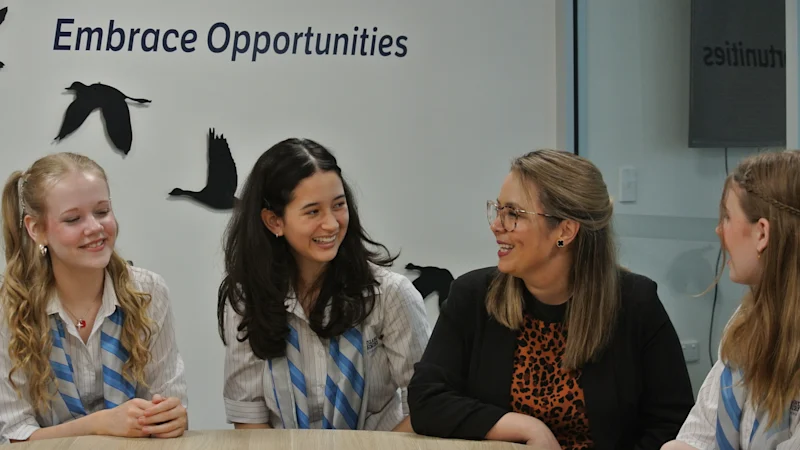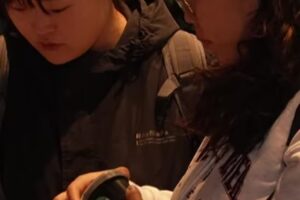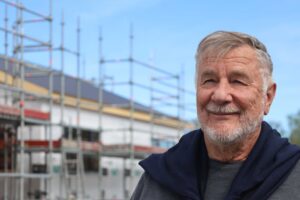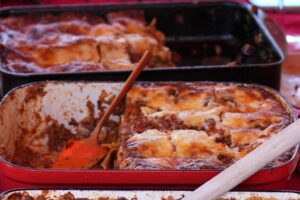
And the imagery itself, Carter said, reflected teamwork, the school’s core tenet.
“The IB is academically rigorous, it is challenging, but we fly in V-formation together – we lift each other up where we need it,” she said.
Student artwork decorates the Queensland Academy of Creative Industries, and the tuckshop name and logo design (right) were created by a student as part of their senior-year project.Credit: Catherine Strohfeldt
Carter said the student body’s culture was QACI’s best asset, reflected in small details such as lockers that don’t lock, with students instead expected to trust one another.
The selective-entry state school only teaches students in senior years, with a single entry point in year 10. By the end of 2025, more than 480 students were enrolled, 80 per cent of whom were girls.
The school accepts between 160 and 180 year 10 students from around the state based on applications, which Carter said the school used to match students to QACI’s culture and learning environment.
“The goal is to identify students who will thrive in the IB environment – students who show commitment to academic growth, personal development, and community engagement,” Carter said.
International Baccalaureate core elements
Theory of Knowledge (TOK): A core subject focusing on epistemology – the study of how we know what we claim to know, and the nature of human knowledge.
Creativity, Activity, Service (CAS): Creative, physical, and service experiences engaging with the community and other schools or helping students with their personal growth.
Extended Essay (EE): A self-directed research project, between 4000 and 5000 words, on a topic of the student’s choice.
The school’s Index of Community Socio-Educational Advantage (ICSEA) value is 91, with about half of the student body sitting in the top quarter of socio-educationally advantaged students nationally.
As it is a state school, families do not pay fees, but cover costs for extracurricular activities and student equipment, including textbooks, laptops, and calculators – estimated to cost at least $850 for the first year.
Families also were required to cover the annual IB payment for the two years their child studied it across year 11 and 12, which cost $2571 in 2025.
Carter said the school looked for students who would be well-suited to the IB program. She said its student-led study model and final-year assessment items prepared students well for university.
She said the school could take up to 30 international students, with about a dozen currently enrolled. But she noted that the IB diploma program – used as an entry credential for most universities in the world, with mandated learning of a second language – was not specifically aimed at international students.
Instead, Carter said most students wanted to be better prepared for university, given the IB program teaches university-level courses in year 12 for half of students’ subjects, referred to as “high-level” classes.
Some students, she said, had gone on to study at Oxford or Cambridge, but many others were drawn to the creative industry classes on offer.
“We are considered a beacon for the arts,” she said. “We’re the only school in the Southern Hemisphere that offers all of IB’s arts subjects.”
Loading
Those subjects include dance, music, theatre, visual arts and film – with the school boasting a 350-seat theatre, a dance studio, design classrooms equipped with 3D-printers, and recording and production booths.
However, Carter estimated fewer than 10 per cent of past students ended up as working creatives.
Flo said she was interested in law, while fellow year 10 theatre student Heidi Setterlund said she wanted to become a child psychologist.
Lixi Caldwell, who was in the same year, said while she wanted a career as an actor, she had taken a high-level course in biology to expand her options.
“If I decide when I graduate that the theatre and pursuing the arts isn’t for me … I’m going to go study, biochemistry or biomedicine,” she said.
“Right now we’re learning about inherited diseases, and it’s really interesting to just figure out how the body works.”
All three studied biology, and said the school was currently using real-world diagnostic techniques and anonymised case studies to teach the topic.
“[It’s] like, ‘what do you mean we’re going to do this in high school?’,” Flo said.





